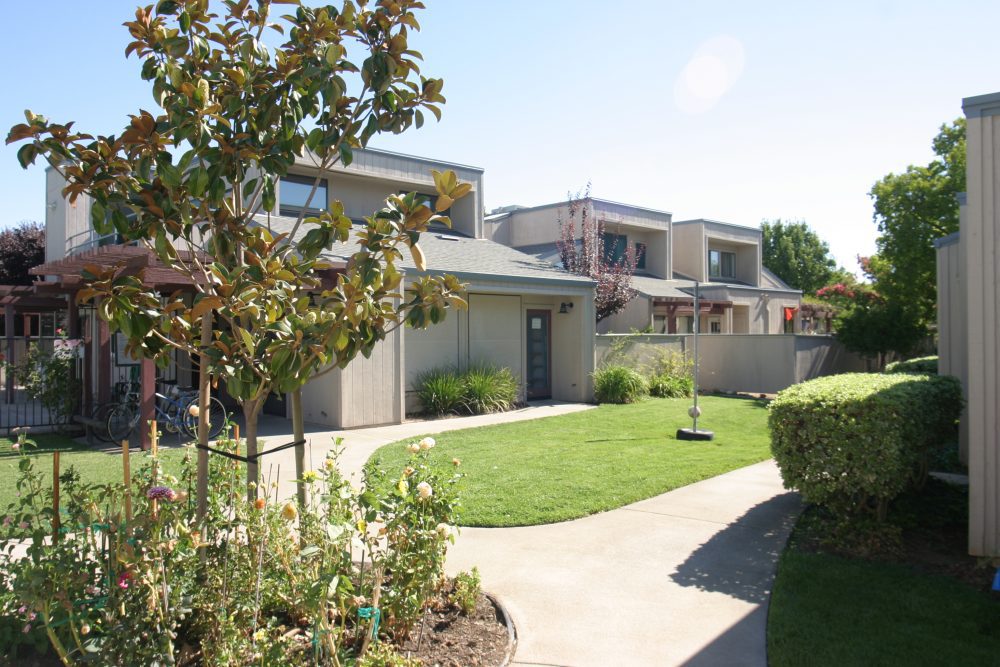
The Dos Pinos Housing Cooperative, the only limited-equity housing co-op in Davis, California, does not impose income limits on who can live there. Photo courtesy of David Thompson
Davis, California, a university town with over 70,000 residents, had only 13 vacant market-rate apartments to rent as of December 2017. That’s a vacancy rate of 0.2 percent, according to an annual University of California–Davis study of the housing market, which covered 83 percent of the city’s market-rate apartments. When the figures in the study for three-bedroom units rented as a whole and those rented by room are combined, we find the average rent for a three-bedroom unit in 2017 to have been $2,388.
Davis is in Yolo County, which had a 2017 area median income of $76,900 for a four-person household. Using the 30-percent-of-income affordability standard, a median-income family of four living in an average market-rate apartment in Davis is paying $5,592 per year more than they can afford.
There is, however, one place in Davis where a median-income family of four is paying far less than not only the average market-rate rental, but less than the HUD standard, which defines cost-burdened families as those who pay more than 30 percent of their income for housing. That community is the Dos Pinos Housing Cooperative, the only limited-equity housing cooperative in Davis. A limited-equity co-op is a type of cooperative intended to preserve affordability for low- and moderate-income households. Members purchase shares in the cooperative that entitle them to live in one of the units and have a vote in the governance and management of the building. Units have restricted resale values and many have income limits for potential members, who pay monthly fees, or carrying charges, to cover their share of the cooperation’s expenses.
The monthly carrying charges to live in one of the 26 three-bedroom apartments in the Dos Pinos Housing co-op, as of December 2017, were $1,165. That’s a savings of $14,676 per year over the average market rent. A household in one of the 28 two-bedroom apartments had annual savings of $9,036, while a household in one of the six one-bedroom apartments had annual savings of $7,452.
Buying a co-op is more affordable than buying a house in the city. The Davis Office and Commercial Real Estate Report 2017 Year in Review reports that the average asking price of a single-family home in Davis is $632,000. The median number of days a house is on the market in the city is just 12. The market is so hot that most sales are paid for with cash, and if not, a down payment of at least 20 percent ($120,000 minimum) is required, making it hard for buyers who cannot pay cash to arrange financing and compete. A median-income family of four in Davis cannot purchase the average home on the market.
Getting More Affordable Over Time
I helped create and finance the Dos Pinos Co-op and have been studying the cost of living there since 1985. It wasn’t always the most affordable place to live in town. In 1985, the co-op started at a monthly cost above the area’s average rent because it was newly built. However, the cost of buying shares in the coop for a three-bedroom unit at that time was $4,880, which was much less than buying a house in Davis, which at the time would have been about $150,000 with interest rates at 12 percent. Many members wanted to live in a cooperative community, as well.
Because no one has pocketed the increased value of the building and land (including individual co-op members), 30 years later the co-op’s monthly costs are 50 percent lower than the average market rate apartment. The co-op has not imposed income limits on who can live there, and it has a three-year closed wait list.
For the past two decades, Davis’s hot housing market has had an extremely low rental vacancy rate. This lack of supply has pushed up rental rates. The co-op, on the other hand, has shown that it has substantially increased affordability. In 2017, a family of four needed to earn only 59 percent of the area median income to be able to live in a three-bedroom apartment at the co-op. In 1985, when the co-op came into existence, a family of four needed to earn 111 percent of the area median income to live in the same unit. Over time, families need less and less income to afford to live at Dos Pinos. The co-op requires people moving in to have a monthly household gross income that is equal to or greater than 2.5 times the monthly assessment. By this standard, a very-low-income family of four in Yolo County is eligible to move into the co-op. There is no other homeownership model in Yolo County affordable to that same family. Saving or borrowing the $33,000 for a share payment is still a challenge for many low-income households. Nonetheless, the co-op finds that households moving in recently have been of mixed incomes: 12.5 percent very low income, 25 percent low income, and 25 percent moderate income.
The combined annual net savings for the 60 households living at the co-op relative to the market cost of equivalent market-rate rental housing in Davis in 2016 was $679,296. This shows definitively that the limited-equity co-op model can generate sizeable disposable household income and create measurable wealth-building opportunities.
The co-op has received no subsidy at any time in its history. It bought the land at market value and erected the buildings at market value. Annually the co-op pays more than $30,000 in local property taxes, just like the market-rate apartment complex across the road.
No co-op apartment at Dos Pinos has ever been foreclosed, and in 32 years, only one member has been evicted. The vacancy rate is always zero and the vacancy reserve is never used. Since 1986, there has always been a waiting list for apartments at the co-op. For the past decade, the waiting list has stood between 60 and 100 families. The waiting list was closed as of December 2017 at 128 families, and will be re-evaluated in April. With an average turnover rate of five apartments per year, the average wait for a three-bedroom unit is about three years.
Dos Pinos holds an additional appeal for families. Because state law requires owner occupancy in an LEHC, all households living at Dos Pinos must be permanent Davis residents. Therefore, there are no student households at Dos Pinos, as the wait to get in is usually longer than the college stay. In contrast, most apartment complexes in Davis are 80 percent or more student-occupied, and even Davis condo associations are over 50 percent student rentals. Many families would prefer family-oriented complexes, but if you are renting, that is not an option in Davis, outside of the co-op.
Inclusionary Housing
The co-op is, in a manner, the first inclusionary housing developed in Davis. In the 1980s, Davis capped how many subdivision units it would approve on an annual basis. Since there were more developers who wanted to build than permits being given, some developers found they might have a three- to five-year wait to get planning approval. To encourage the construction of permanently affordable housing, the Davis City Council adopted a policy that would allow developers to build up to 120 units in limited-equity housing cooperatives outside of the housing unit rationing at any time. In 1983, one developer stepped forward to take up the challenge and proposed a 60-unit co-op (which later would be called Dos Pinos). The co-op was one of the earliest limited-equity housing cooperatives to be approved under a California state law that had been enacted in 1979. The co-op was completed in late 1985, and fully occupied by 1986.
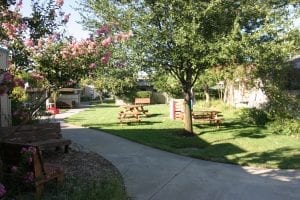
The co-op was one of the earliest limited-equity housing cooperatives to be approved under a California state law that had been enacted in 1979. The co-op was completed in late 1985 and fully occupied by 1986. Photo courtesy of David Thompson
After that, the city adopted requirements that each new Davis subdivision or housing development must include land set aside for permanently affordable housing. Almost all of that land has been developed by nonprofit housing organizations using tax credits to build over 1,000 rental units to reach mostly low- and very-low-income households.
In 2000, Davis residents approved a ballot measure whereby any annexation of land by the city requires citizen approval. Since then, all four efforts to annex land to the city have been defeated at the polls. In February 2018, the city substantially reduced its affordable housing requirements for multifamily developments, and given the present climate it is likely that there will be few land set-asides in the near future.
California’s limited-equity cooperative housing law was first introduced by Assemblyman Tom Bates of Berkeley and adopted in 1979. In 2009, the California Legislature unanimously voted in favor of a bill—authored by Assemblyman Dave Jones of Sacramento—that extensively revised the law.
The key elements of the law are:
- There is one vote per member household.
- The co-op unit must be owner occupied (no rentals).
- The individual member share cannot be more than 10 percent of the unit cost.
- A member can receive no more than 10 percent return a year on their share. Most co-ops set the rate at less than 5 percent. That return is noncompoundable and not returned to the member until they leave the co-op.
- The value of the entire co-op, if there is dissolution, shall be distributed in the following manner: If there are funds remaining after paying off all obligations, each member household shall receive their full share investment plus the interest on that share, but no more than that; all remaining value must be contributed to a nonprofit tax-exempt entity.
Fewer than 50 apartment-type limited-equity housing co-ops have been developed in California under the LEHC laws. Almost all were developed from 1980 to 1990, when the National Cooperative Bank was able to partner with programs of the state of California that also supported the development of limited-equity co-op housing. After 1990, most jurisdictions and nonprofits in California moved to use their limited resources to develop affordable rental housing with tax credits as the key financing tool. The normal limited-equity housing cooperative is not eligible to use tax credits so interest in those cooperatives petered out.
The Unique Nature a Housing Cooperative
A unique aspect of a limited-equity housing co-op relative to all the other equity sharing models is that the appreciated of value of the housing is all retained in the co-op and in the community. When a member leaves an LEHC, the only economic transaction is what was initially paid for the unit plus interest earned. This means the balance sheet of the co-op is unaffected economically by any change in membership. All the economic gain in value stays in the co-op.
While this might seem like a limit on asset accumulation for co-op members, remember that almost all of the 8,000- plus families living in a market-rental apartment in Davis are not building assets, in housing equity or outside of it.
Meanwhile, for 2017 a co-op member’s annual return on share investment could be considered to be 52 percent, if you include cost savings compared to other available housing options in Davis. A member joining the co-op on Jan. 1, 2017, would have invested in a refundable share of $33,000. The savings in monthly costs compared to market rate would be $14,676, and the 3.25 percent interest earned on their share ( for 2017) would come to $1,072. (Annual interest rate is set at the prime interest rate, up to a maximum of 10 percent.) This amounts to $15,748, or 52 percent of their $33,000 investment. If market rental prices continue to rise faster than co-op costs, this return could get even higher. In addition, a number of members take a tax deduction for their portion of the mortgage interest and property taxes (co-ops are eligible for these deductions and members of housing cooperatives are seen as homeowners by the IRS), adding potentially a few more percentage points of return.
The co-op as an ownership model also brings savings in transaction costs. As there is no change in the building mortgage, only a transfer of ownership shares, there are no real estate transaction costs for the member when joining or leaving the co-op or for the transfer of the co-op unit. Transaction costs for condo purchases in Davis are more than $10,000, and higher for single-family homes. Having no real estate costs at the co-op is a major savings for both seller and buyer. Each year on average, members who move in and out save a combined $50,000 or more in real estate transaction costs.
Given the economic return over time, an LEHC could also be a good thing for groups such as teacher associations and unions to bargain for: A housing cooperative for teachers would give educators far more economic gain per year than could be gained from salary increases, while demanding less ongoing input from the school district. An LEHC could even help recruit teachers and staff. A district could provide leased or low-cost land in return for school district employees being given first preference for the apartments. The school district could also lend funds to eligible employees to help them invest in their co-op share.
Limited-equity co-ops as a structure have a number of advantages when it comes to creating deep and lasting affordability. In other “shared-equity” models, the seller may leave the project and the community and take some equity gain with them; that does not happen in the co-op. Since all the gain in equity and value is retained by the co-op, and therefore in the community, increasing subsidies are not needed. In fact, as we have seen, affordability can increase over time. This means that over time a LEHC can bring a form of homeownership to a lower income group than almost any other “shared equity” model.
One affordable co-op in one high-rent city in 30 years does not a movement make. However, of the homeownership options for the “missing middle,” the LEHC has tremendous potential. An LEHC would work well for many types of organizations that might have land to set aside for a cooperative community, and funds to help lower-income families purchase the co-op share, such as local, state, and other government agencies; unions; churches; veterans groups; and other affinity groups.
Given the massive need, there ought to be many more limited-equity housing cooperatives like Dos Pinos creating “wealth generating” housing for the forgotten American family.

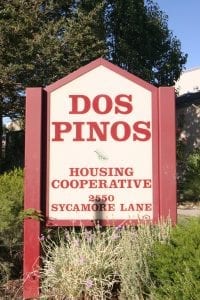

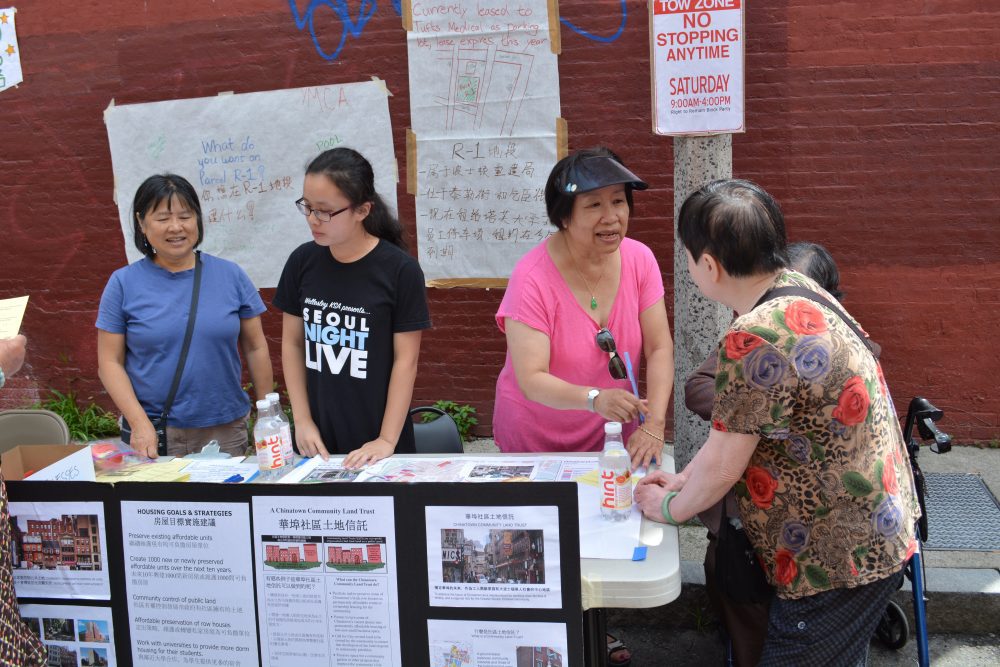

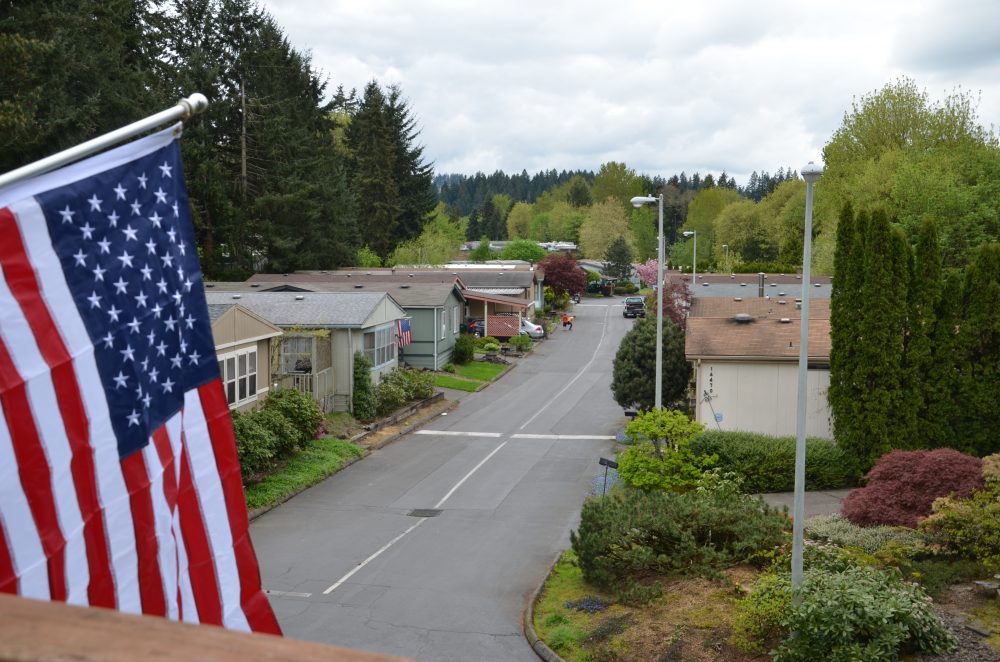
So the solution to the housing crisis comes with a 3 year wait list.
Interesting to think what that would do if rolled out across the region.
Arthur, There’s a three year waiting list for this little known housing option because it is so attractive for many people. If thousands of units were available, the waiting list would be shorter.